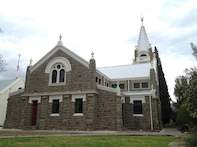Small Town Settlement
Change is inevitable, even more so when you are a small town in the Western Cape of South Africa. Laingsburg was originally known as ‘Buffelsrivier’ due to its location along Buffels River, and then ‘Nassau’ as not to be confused with another Buffalo River found in the Northern Cape or the one in Eastern Cape for that matter.

In 1881, the town obtained its current and official name of Laingsburg in honour of the Commissioner of Crown Lands (or Properties) in Cape Colony, John Laing.
Two decades and several new settlers later, the town obtained municipal status. This new status allowed the town to be self-governing under the national laws established by the governing state.
Geological Site
Laingsburg is located in a geological site rich with information from the ancient past. Geologists and palaeontologists are known to visit the area to further their research into their respective fields. One distinguished palaeontologist, Dr John Almond, discovered a fossilised 15 metre long trackway of a giant water scorpion in rocks found near Laingsburg. This is the biggest and most sophisticated trackway of its kind ever discovered.
Considered one of the most important invertebrates to have existed, the water scorpion (eurypterids), belong to a group of extinct aquatic arthropods that emerged during the Palaeozoic period.
The palaeozoic era occurred from about 542 million years ago to 251 million years ago, while the tracks that were discovered are believed to have been made 270 million years ago. The ancient giant water scorpions are the direct ancestors of scorpions and spiders.
Continuing on this theme of geological discovery, a solitary band of white quartz stretching between the town of Matjiesfontein to Laingsburg was found by geologists undertaking research within the area.
Expectedly, these discoveries have led to a geological and ecological interest in the area, which in turn has generated a hiking trail called ‘The Blockhouse’ located along the N1. The original inhabitants of the area - the San, are believed to have used shards of this natural material in the production of their arrowheads.
Further discoveries have revealed the Karoo was once saturated in water and lush greenery due to evidence of ancient glaciers found in the region.
The fossilised remains of dinosaurs have also been unearthed along with the geological evidence that Africa, South America, Australia, Antarctica, the Indian subcontinent and the Arabian Peninsula was once one landmass known as Gondwanaland - a supercontinent.
Devastating Flood
In 1981, the town of Laingsburg was ravaged by a devastating flood, which claimed the lives of 104 people of which 72 bodies were never found. For three days straight, the Karoo region was drenched in unabating 425 mm rainfall (the average rainfall being 175 mm) resulting in the flooding of Buffels River, which in turn moved its way towards Laingsburg.
The flood reached a height of 10 metres above its standard flow-level creating catastrophic levels of destruction as it claimed people, their homes and possessions, livestock and neighbouring vineyards in its torrential grip.
Those individuals who survived, did so by clinging to anything that floated by and were later rescued nearly 20 metres away, in Floriskraal Dam, from the town that was once their tranquil home.
The enormity of the flood was of such a scale that many of the victim’s bodies were never found, while others were located as far away as Mossel Bay, nearly 250 km from Laingsburg. The flood demolished 184 houses and 23 trade and commerce buildings. Evidence of the flood can be seen on the town’s Dutched Reformed Church and on street lights (lamp posts) which are marked by high water lines.
The government set about restoring the town’s infrastructure, building new houses, commercial buildings, a boarding school and sporting complex. This redevelopment left the town looking quite modern in relation to other towns in the Western Cape region.
In addition to the high water lines indicating the town’s traumatic past, the town furthermore has the Flood Museum, which acts as a repository of the natural disaster that devastated Laingsburg. The museum exhibits other collections like the Wolfaardt Collect of Africana, collections that showcase the Anglo-Boer War and Great Trek, historical weapons and the prehistoric artefacts.
Laingsburg was met years later with similar floods in the years 2008 and 2014. However, the damage incurred was minimal.